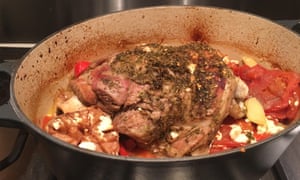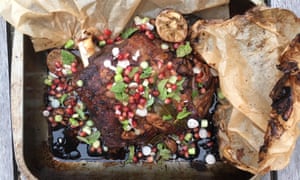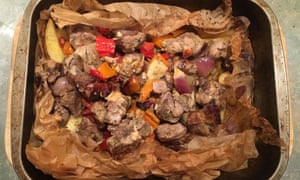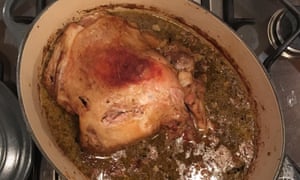How to cook the perfect kleftiko
This classic Greek dish needs some serious time and TLC. But the results are more than worth it

One of the undisputed classics of Greek cuisine, kleftiko is a special-occasion dish which showcases Hellenic cooking at its simple best. It demands no fancy ingredients or tricky techniques, just good raw materials and a good deal of patience. Said to be named after sheep-rustling bandits known as the klephts, who would cook their ill-gotten gains in underground pits to avoid detection, the success of the dish depends on long, slow roasting until the meat fairly falls off the bone. Thats handy, no doubt, when your knives were all engaged in more nefarious activity.
Though its no doubt at its best at a whitewashed island taverna, its also perfect for feeding a crowd when the circus of fire and knives that is our traditional Sunday roast feels like too much effort. Like many of the best summer dishes, kleftiko is happy to do its own thing while you get on with more important stuff such as sunbathing and drinking ouzo.

The cut of lamb
Most recipes I try call for leg. Rick Stein uses a whole one, while Sebastians Taverna in Corfu and Eli K Giannopoulos of the website My Greek Dish plump for pieces. The testing panel, however, is largely with Georgina Hayden, author of Stirring Slowly, who describes kleftiko as her achilles heel but calls for shoulder, as does Tonia Buxtons recipe.
Though leg looks impressive, and one tester prefers its relative leanness, everyone else feels like its a cut better suited to cooking fast and serving pink; the tougher, fattier shoulder, meanwhile, really benefits from slow cooking, becoming wonderfully juicy and rich. Its also cheaper, which is always a pleasing bonus.
Those short of time might prefer to use Buxtons leg pieces on the bone, which only need cooking for a couple of hours, though Im slightly of the opinion that this is a dish that deserves a bit of love, and youre probably better off making something else.

The cooking
While were on the subject of time, Giannopoulos marinates his leg steaks for 24 hours before cooking, which gives them a wonderfully deep flavour. If you dont have that luxury, however, rest assured that it will still be delicious.
Sebastians Taverna is the only recipe to braise the kleftiko on the hob, rather than baking it in the oven. Theres no doubt that this keeps the meat beautifully juicy, but it doesnt have the same intensity of flavour as the others, especially since the pieces are submerged in water. Adding less liquid, as Stein and Hayden recommend, gently steams the meat, so its moist, but still retains its distinctive flavour rely on its own juices, as Buxton does, and you get a great-tasting kleftiko thats just a touch dry.
Stein and Giannopoulos both bake their dishes at a high heat: 190C and 180C respectively, but for shoulder, I think Buxton and Haydens gentler 160C gives better, more tender results. Equally importantly, make sure its in a tightly sealed package, either in a heavy casserole dish, sealed with foil, as Stein recommends, or in a completely closed parcel of greaseproof paper sprinkled with water as in Haydens recipe, so no moisture can escape.
Though I suspect this is unorthodox, Giannopouloss final blast of heat, with the meat uncovered, does help boost the flavour, just as a melt-in-the-mouth sous-vide steak is made infinitely tastier by a brief dance on a hot grill.

Vegetables
The simplest recipe, from Sebastians Taverna, calls for nothing more than onions and garlic, and Hayden, though she uses more spice, sticks with garlic alone. But, as youve got the oven on anyway, it makes sense to cook a few vegetables at the same time. Stein, Buxton and Giannopoulos bulk the dish out with potatoes, which are gorgeously rich and soft after a few hours with a joint of lamb (and even better crisped up while the meat is resting as Giannopoulos suggests) make sure you get the waxy kind, or youll be left with mush. Everyone peels them, but I think theyre even more delicious left whole, whatever Greek grannies might think.
Stein and Giannopoulos both also add peppers, and, like Buxton chuck a few tomatoes in there for good measure, which not only look colourful, but, as with anything given such a treatment, taste great too. Theyre not absolutely necessary, but they do help make this dish into a one-pot treasure trove.
Garlic, however, is very much necessary and the sharp flavour of the crushed kind is so different from the mellow sweetness of the roasted variety that Im going to use it as both seasoning and vegetable. The sugary heat of Giannopouloss red onion works similarly brilliantly with the savoury lamb.
Stein adds crumbled feta to his kleftiko, inspired by the one served at a restaurant in Symi, and Giannopoulos goes for kefalotyri, a very versatile hard yellow cheese that, to my surprise, I find in the supermarket, though Ive never noticed it before. Both have a tendency, however, to dissolve into the vegetables, prompting one tester to discreetly remove several blobs of what she believed to be lamb fat before I set her right. Cheese and lamb are not, to my mind, a marriage made in heaven, but if you fancy adding some, do so right before serving.
Haydens recipe has a non-traditional twist right at the end its finished with a scattering of pomegranate seeds and mint tossed in a little red vine vinegar, which is a very pretty idea if you decide not to add any extra vegetables, and serve this with salads instead.

Seasonings
Oregano is an absolute must I find the dried kind stands up better to long cooking than the fresh leaves and a couple of bay leaves, as used by Buxton and Hayden, dont go amiss either. A little acidity in the form of lemon juice, rather than Giannopoulos white wine, helps to cut through the richness of the meat and potatoes, so you can keep going back for more. Best followed by a glass of raki and a nap in the shade of a gnarly fig tree.
Perfect kleftiko
(serves 6)
1 lamb shoulder, about 2kg
Olive oil
1 tsp cinnamon
1 tsp dried oregano
1 tsp salt
1 1/2 heads of garlic
2 lemons
1 kg waxy potatoes
1 large red onion
1 red pepper
1 bay leaf
12 cherry tomatoes
Rub the meat with oil. Sprinkle over the cinnamon, oregano and salt, and peel and roughly crush half a head of garlic. Rub all this into the meat with your hands along with the juice of one lemon. Cover and leave for 12 hours.
Heat the oven to 160C. Cut the potatoes into wedges and use them to line the base of a large lidded casserole dish (or use a roasting tin lined with enough parchment paper to fold over the top of the joint on both sides youll probably need two pieces at right angles). Cut the onion into wedges and the pepper into chunky strips, removing the seeds, then add the cherry tomatoes. Place the lamb on top. Cut the remaining garlic and lemon in half laterally, squeeze the lemon briefly over the potatoes, and tuck the shells and the garlic in around the joint along with the bay leaf. Pour 200ml water into the dish. If using a casserole dish, tuck a damp piece of greaseproof on top and cover, if using a roasting dish, sprinkle the overhanging paper with water and fold over and tuck in to form a sealed package. Bake for 4-5 hours until very tender.
Turn the oven up to 220C and roast, uncovered, for 10-15 minutes at this higher temperature, then lift the joint out and set aside. Put the vegetables back in for 15 minutes until starting to brown, then serve with the meat.
Kleftiko: Greek cooking at its best? Do you like to keep yours simple, or make it a meal in itself like this one? And what do you serve with it?
Read more: https://www.theguardian.com/lifeandstyle/wordofmouth/2016/aug/18/how-to-cook-the-perfect-kleftiko
